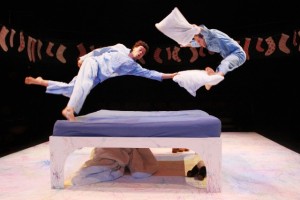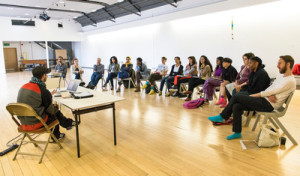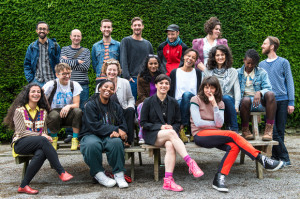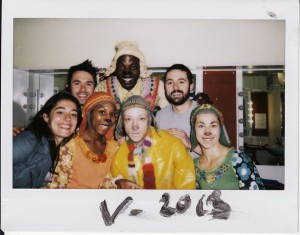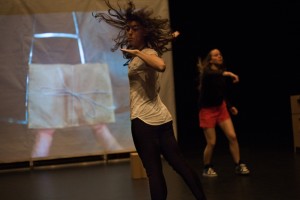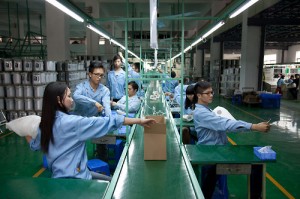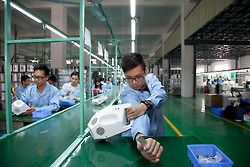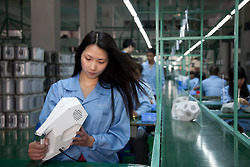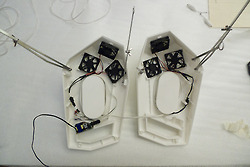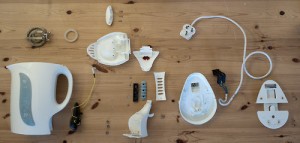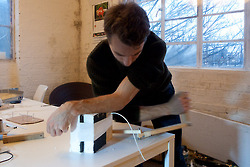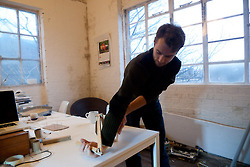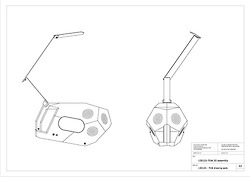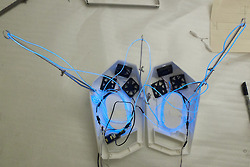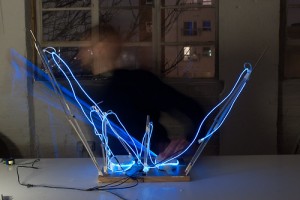Since the last installment of my catch up series of blogs I’ve been on a half-term run of Boing! at the Sherman in Cardiff. The end of the 8-show run coincided with my 30th birthday, which gave me pause for thought; I don’t think many people spend their 30th birthdays dressed in pajamas bouncing around a bed pretending to be 8 years old in front a hundred people. The show itself, which was something like our 140th performance, was, for better or worse, something of a memorable outing, mostly thanks to an error on my part.
It was during a section near the beginning of the show which involves me chasing Joel around the bed with a pillow; it’s the sort of energetic chaos involving pillow swipes, bed flips and near misses that only well-honed choreography can deliver. Only on this occasion it was somewhat less well honed and I misjudged the distances involved in a pillow power-uppercut designed to miss Joel’s bottom at high speed with only inches to spare. Much to his surprise and the delight of the audience the pillow, which was perhaps slightly more than a few inches out, not only missed his bottom, which was being brandished in my direction for dramatic effect, but rocketed up between his straddled legs, once again with the kind of speed that only choreography can deliver, and caught him squarely in the balls.
Like any dancer who’s just been dealt a swift frappé to the testicles, fight or flight displaced the choreographic thought process and he defaulted to running around the bed like a … well like an 8-year-old boy that’s just been cracked in the family jewels. Once the shock subsided he slotted back into the choreography like any true pro would and all the people who witnessed the show were none the wiser to the fact they had seen a one-off special improv version of Boing! A rare version that should probably never been seen again – I don’t think he would be so forgiving a second time.
Following on from the point I reached in my last blog , I’d just about got to the heights of the summer and the end of the Varmints tour. Directly after this I made my way down to Plymouth with Shantala Pepe to dance in her new short dance film – a short piece based on a couple sitting in repose upon a cliff-top bench looking out to sea. It was a week-long process to devise and shoot, and the rushes looked quite beautiful; it’s currently being edited by Shantala but I will keep you posted on its development.
After wrapping up in Plymouth it was only a short journey to Dartington for the 3rd year of the annual gathering of the Sadler’s Wells Summer University. For those of you that aren’t sure what that is, it’s a four-year programme studying the art and craft of choreography, led by choreographer and writer Jonathan Burrows. It is part of the Jerwood Studio at Sadler’s Wells’ research programme, which supports the development of large-scale projects, alongside other professional development initiatives. There are 15 of us, emerging choreographers, including fellow New Wave Associates, Hetain Petal and Alexander Whitley.
We often don’t see much of each other throughout the year so it’s always interesting to re-converge in the light of the discussions and guest lectures to see how each others’ paths have changed. One of the things that has always been a prominent feature of the group is our diverse range of backgrounds and practices. This year, this aspect of the group took on a new enhanced value as the group felt a degree tighter and closer than in previous years. As a freelancer often working with different groups of people, to engage regularly with a core of people working the same way as me, but totally differently at the same time, is an amazing insight as well and opportunity for reflection. It’s going to seem very strange to think that next year will be our last, and that we’ll be without Emma Gladstone. Emma, who initiated the University and has been with us every year, is every bit as much a participant as the rest of us, in the mix of the discussion and debate as well as beside us all as we take steps going forwards in our work and careers. After moving on from Sadler’s Wells to take on new challenges at Dance Umbrella, I hope she won’t be able to resist dropping in to see us next year.
And on that note my train is drawing in to the station, and my week off is about to begin. It’s been two months since I’ve been home, and I think I should be able to fill you in on the gap between here and there in one last catch-up blog. I’ll endeavor to get that written before the intense push towards to Xmas at the Sadler’s Wells’ LBS that begins a week from now. In the meantime, check out the tour dates for Boing! and see if you can catch us somewhere.


